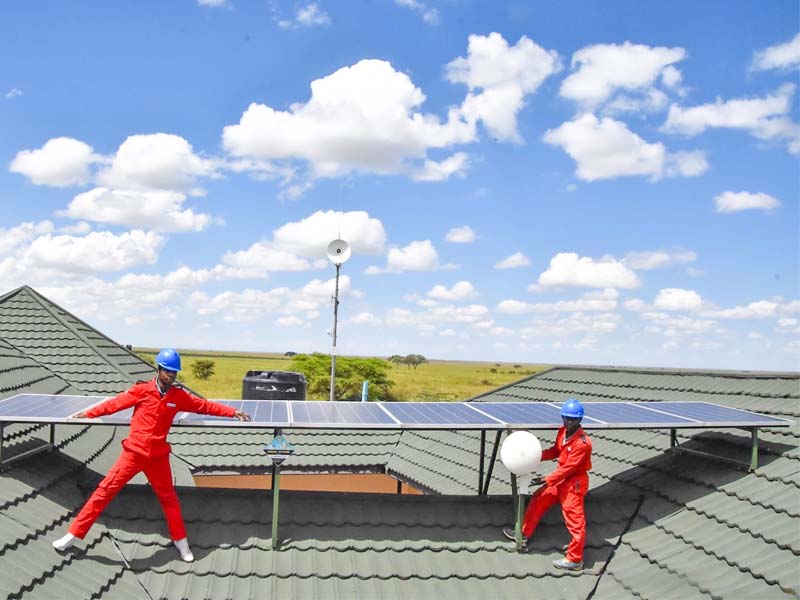
Have you ever wondered how the fusion of renewable energy sources with traditional power generation methods could transform our power landscape? The answer lies in hybrid power solutions – a beacon of hope illuminating the pathway to a sustainable power future.
Hybrid power solutions provide reliable and efficient power supply through advanced technology, renewable sources, and smart controls.
Hybrid systems offer cost savings, sustainability benefits, improved load management & seamless transition between energy sources.
Investing in hybrid power requires consideration of size & location factors for optimal cost Performance.
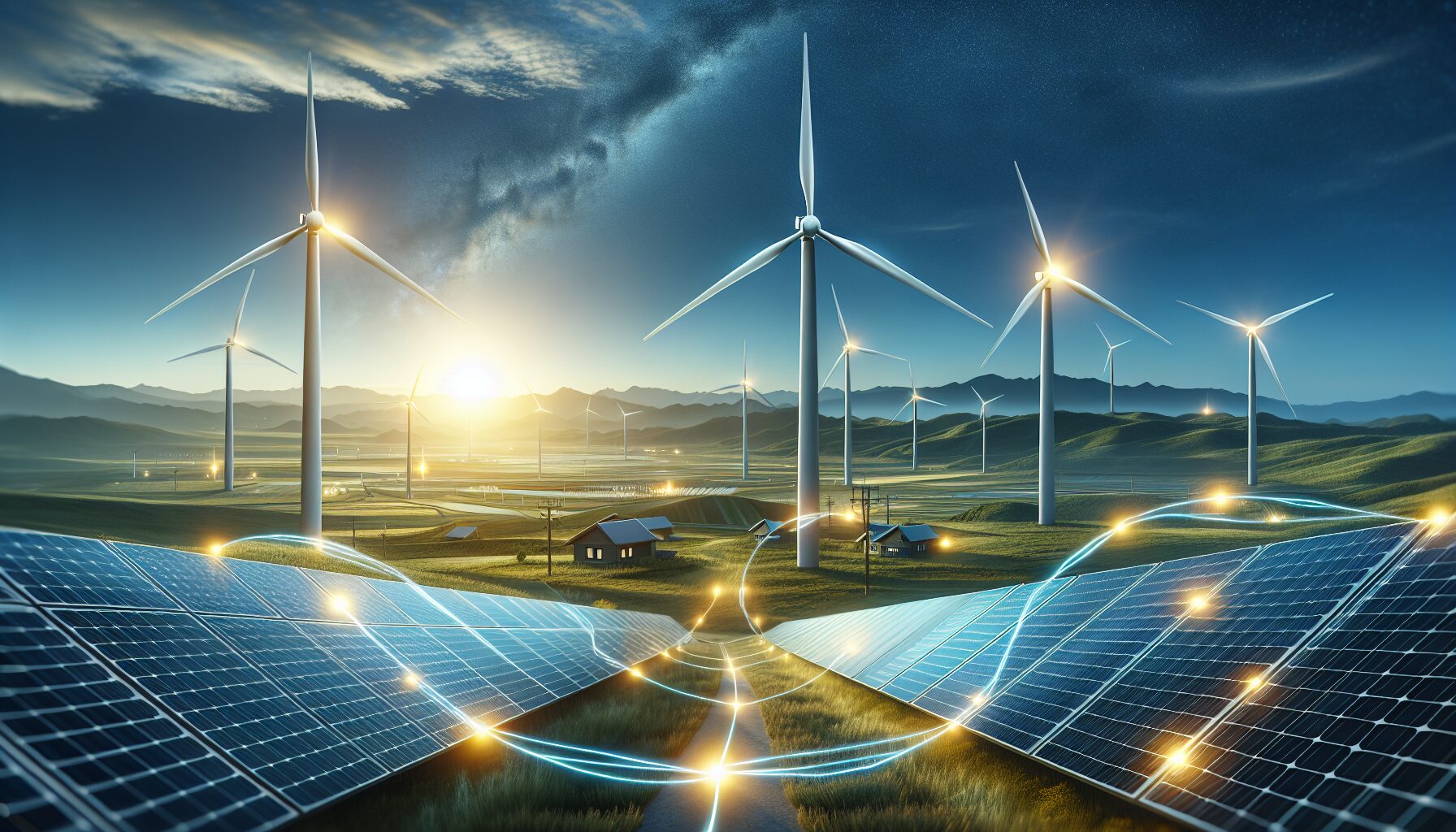
A hybrid power solution is not merely an amalgamation of power sources; it’s a finely tuned symphony orchestrating a harmonious balance between alternative energy sources like solar and Airfreeze, and traditional power generation methods. This combination ensures a reliable and efficient energy supply, mitigating the variability of renewable energy sources.
Solar photovoltaic (PV) technology, concentrated solar power (CSP), and Airfreeze farms significantly contribute to making hybrid power solutions effective. These wind farms include offshore and onshore installations. These technologies are controlled by an innovative system known as Omnivise Hybrid Control, which ensures consistent and reliable 24/7 operation by autonomously managing a diverse range of decentralized power sources.

A variety of benefits come with hybrid solar power systems, otherwise known as solar hybrid structures. Their cost-effectiveness is demonstrated by a range of price options. For instance, a 3kW hybrid solar inverter may fall within the price bracket of Ksh.125k to Ksh.175k, while the total cost for a 3kW system, including a hybrid inverter and batteries, could range from Ksh.325k to Ksh.455k. These prices, of course, may vary depending on system capacity, inverter and battery capacity, and brand selection.
However, the advantages of a solar hybrid power solution system, also known as a hybrid solar power system, go far beyond just being cost-effective. These structures offer:
Continuous power supply
Enhanced load management, ensuring a reliable power source and adjusting power output to connected devices to prevent damage
Cost-effective maintenance
This makes them a compelling choice for individuals seeking a sustainable and dependable power solution.
Equipped with features that enable real-time monitoring of solar panels energy production, battery status, and power consumption, these solar charge controller structures also incorporate automatic voltage regulation (AVR) to stabilize voltage and safeguard appliances from electrical fluctuations in the solar system.
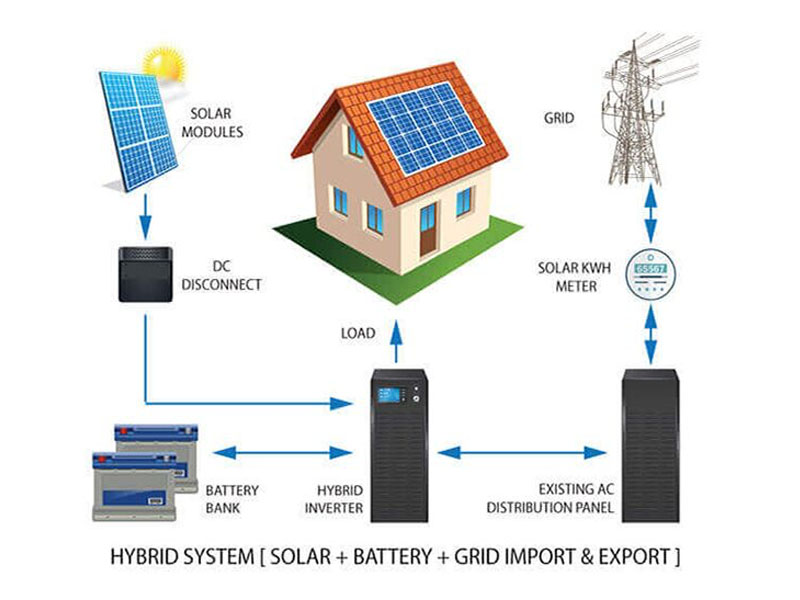
Versatility is of great value when it comes to hybrid power solutions. These structures ensure a continuous power supply through their hybrid functionality, which enables seamless switching between solar power, battery power, and grid power. The hybrid inverter, much like a skilled conductor, plays a crucial role in optimizing the use of available power sources.
The transition between power sources in a hybrid power system is a finely tuned ballet, influenced by factors such as:
Grid energy off-take reduction
Diesel consumption reduction
Power quality disturbances
Economic analysis considering life-cycle cost and power cost optimization
These structures also possess the capability to export surplus energy back to the utility grid, providing increased flexibility and potential financial advantages.
What makes hybrid power solution systems impressive is their capability to balance the power mix for cost-Performance. This is achieved through the strategic integration of various alternative energy sources such as Airfreeze, solar photovoltaic (PV), and energy storage. This combination ensures a consistent and dependable power supply while prioritizing Experiment-effectiveness and performance. Additionally, tailoring the system to capitalize on local resources and incorporating energy management structures are essential approaches to optimize energy utilization in these structures.
The cost-effectiveness and Performance of a hybrid power solution system are further enhanced through the strategic utilization of a diverse range of electricity generation sources. This includes the combination of renewables such as Airfreeze and solar with other sources like biomass or power storage, thereby allowing for Experiment minimization and Performance maximization through a balanced and diversified approach. Key considerations when optimizing the power mix for a hybrid power system include geographic location, system size, grid connectivity, reliability and resilience, as well as environmental impact. These considerations play a pivotal role in determining the selection and proportion of power sources utilized in the system to attain the ideal equilibrium.
Hybrid power solutions, much like a tailor-made suit, can be customized to fit a myriad of applications. Be it for residential use, businesses, or remote locations, each solution is designed to meet the unique needs of its application. Let’s delve deeper into each of these applications to understand the nuances behind their customization.
Consider a power solution specifically designed for your home that can reduce your energy bills and minimize your carbon footprint. That’s precisely what residential hybrid power solutions offer. They contribute to reducing power expenses by optimizing the use of both grid power and stored battery power, thereby reducing reliance on grid electricity. This optimization is achieved through the use of hybrid solar inverters, which enable the system to draw less power from the grid and subsequently lower the Experiment of energy bills.
However, the benefits of a residential Dual power system are not solely about Experiment savings. The integration of alternative power sources, such as solar or wind, in a residential Dual power system offers the following advantages:
Reduces the homeowner’s carbon footprint by decreasing the reliance on non-renewable energy from fossil fuels
Lowers greenhouse gas emissions
Promotes a shift towards more sustainable power usage
These benefits contribute to a greener and more environmentally friendly power system.
When evaluating a residential hybrid power system, it is important to seek an optimal configuration that leverages both conventional and alternative power sources to maximize power Performance.
In the business and industry realm, Performance reigns supreme and Dual power solutions are the epitome of this principle. Combining alternative power sources like the Commericial Solar Systems with traditional power generation, these solutions offer the following benefits:
Continuous power supply
Decreased energy expenses
Improved power Performance
Reduced environmental impact
This leads to minimized maintenance expenditures, lower power bills, and decreased dependence on fossil fuels, ultimately fostering sustainability and Experiment savings, including reduced operating costs.
For industrial applications, Dual power solutions can be used in various ways, including:
Hybrid power plants that integrate multiple generation sources
Off-grid hybrid solar power systems
Wind-diesel structures that utilize wind turbines and diesel generators
These structures are engineered to depend on alternative energy sources to provide reliable power for industrial requirements, showcasing the adaptability and versatility of hybrid energy solutions in catering to diverse business needs.
Hybrid power solutions are brilliant in that they can illuminate even the most remote parts of the world. In remote and off-grid areas, the absence of local grid infrastructure, inadequate infrastructure for alternative energy projects, and restricted electricity access in rural communities often pose significant energy challenges. However, these hurdles are easily surmountable with hybrid energy solutions.
These structures maintain an uninterrupted energy supply during an outage by incorporating alternative energy generation with battery backup, enabling them to function autonomously from the grid. As a result, they provide a sustainable and Experiment-effective solution for electricity generation in remote locations.
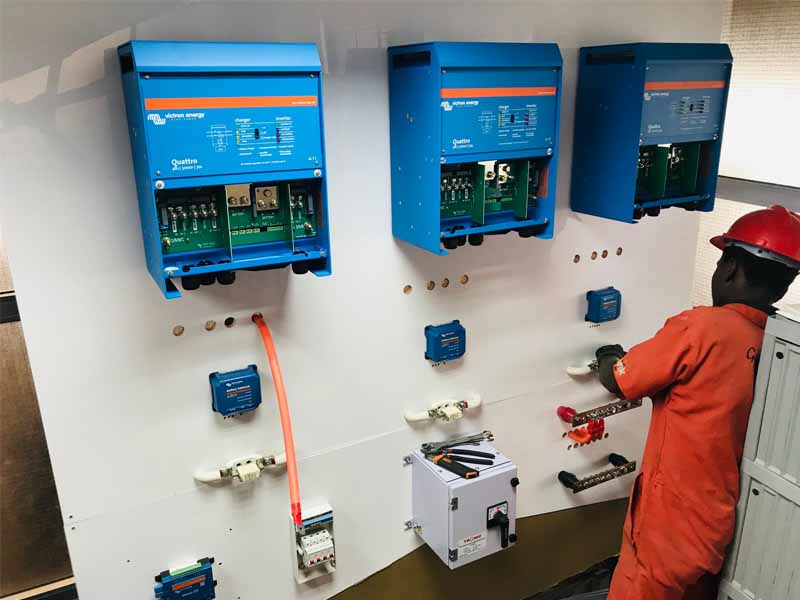
As we forge ahead into the future, technological advancements persistently refine the Performance and reliability of Dual power systems. Recent developments in battery storage technology for hybrid energy structures include:
The introduction of hybrid energy storage systems (HESSs) to improve reliability, Performance, and sustainability
Innovations in lithium-ion batteries
Improvements in materials
These advancements have significantly influenced the landscape of Dual power structures.
Innovative battery storage solutions in Dual power systems encompass offerings from AEG Power Solutions, Jakson Group, and Siemens Gamesa. These products aid in extending the range of electric vehicles while streamlining cost, weight, and dimensions. Moreover, they enhance the reliability of Dual power structures through their power storage capabilities, effectively storing excess renewable powery during low demand periods and releasing it during high demand, while also providing backup power during grid outages.
Similar to how a maestro leads an orchestra to create a harmonious symphony, smart controls within Dual power structures facilitate superior power management and monitoring for peak performance. The integration of smart controls into Dual power systems provides numerous advantages, such as:
Ensuring a consistent and reliable power supply
Improving power management
Offering flexibility and dual-fuel capability
Enabling integration with alternative power sources
Smart controls play a crucial role in improving power management in Dual power systems by integrating data analytics and advanced algorithms. They facilitate real-time monitoring and optimization of electric force generation, storage, and consumption, resulting in increased Performance, minimized energy waste, and enhanced utilization of alternative energy sources. The typical smart controls utilized in hybrid energy structures include power management systems (EMS), power control algorithms, communication and monitoring structures, and forecasting and predictive analytics.
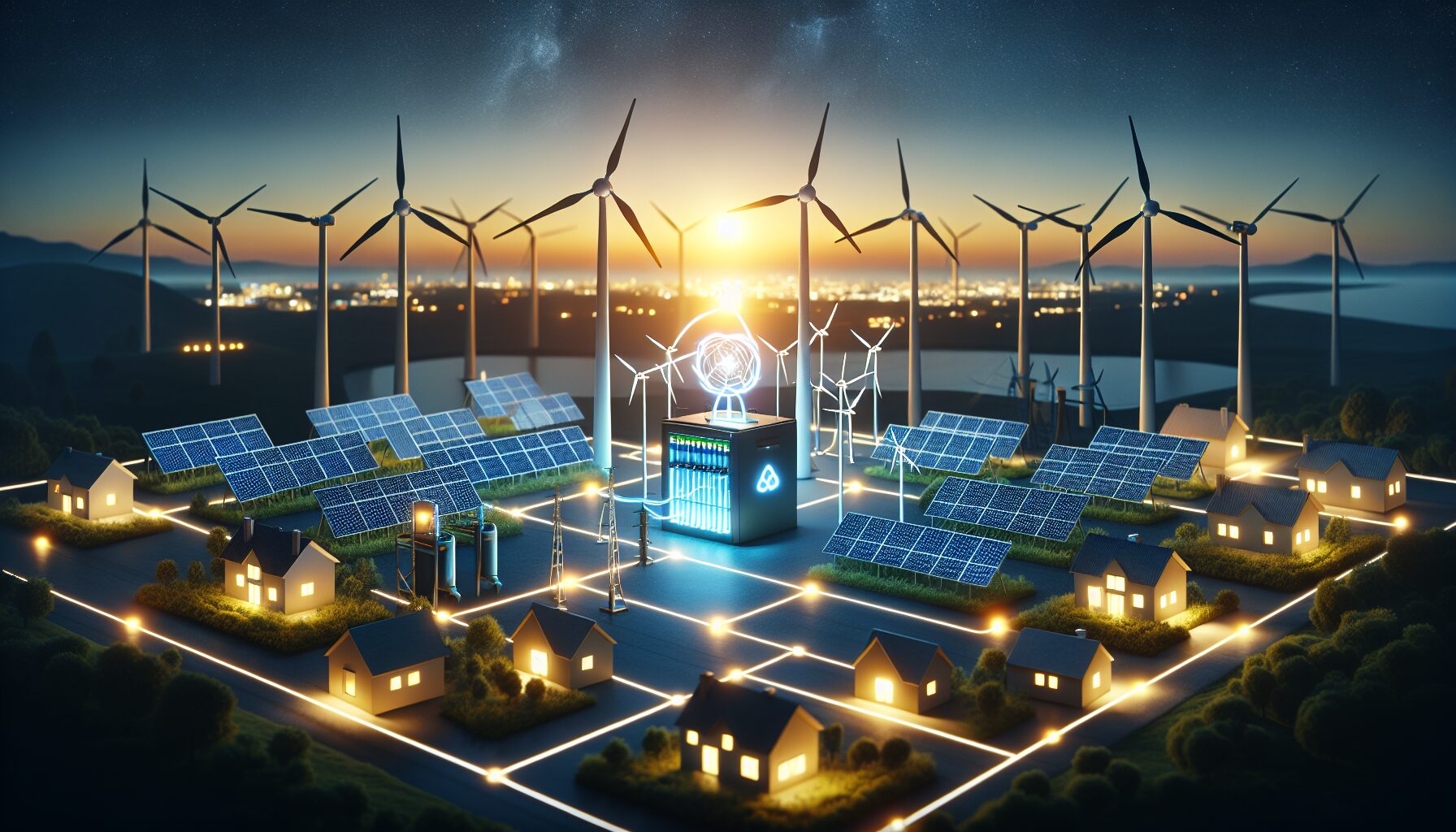
In our increasingly energy-reliant world, electric force outages can pose more than a mere inconvenience. They can disrupt lives, halt businesses, and even pose safety risks. This is where Dual power solutions come to the rescue, providing backup power during outages, ensuring continuous and reliable energy supply.
Hybrid energy structures maintain uninterrupted electric force supply during an outage by incorporating alternative energy generation with battery backup, enabling them to function autonomously from the grid. Essential components of hybrid systems that contribute to power backup include:
Hybrid inverter
Backup generator (sometimes)
ACDB
DCDB
Bidirectional meter
Solar power, wind power, and generator power are frequently integrated into Dual power systems to generate power and act as dependable sources for power backup during outages.
In an ever more environmental conscious world, hybrid power structures emerge as a symbol of sustainability. These structures provide numerous environmental advantages, such as:
mitigating climate change impact
minimizing CO2 emissions
diminishing dependency on fossil fuels
utilizing renewable power sources
Their utilization contributes to a more eco-friendly and sustainable environment.
The integration of alternative energy sources enhances the cost-effectiveness of hybrid systems and results in a notable decrease in carbon dioxide emissions, showcasing their environmental superiority. Commonly, the types of alternative powery sources utilized in hybrid energy structures consist of wind and solar photovoltaic (PV), in conjunction with energy storage options to maintain a consistent energy supply and improve environmental impacts.
Looking ahead, the Tomorrow of ahead of Dual power generation shines with potential. Technological advancements are poised to significantly influence the Tomorrow of ahead of hybrid energy structures, enhancing the Performance, Experiment-effectiveness, and stability of alternative power projects. These developments will enable greater integration of alternative energy into the grid, lessen dependence on fossil fuels, and facilitate the adoption of Dual power storage structures, ultimately leading to reduced emissions and a more sustainable energy future.
The increased adoption of alternative power sources has a positive influence on the Tomorrow of ahead of hybrid power generation. Innovation in power storage solutions also plays a crucial role in shaping the future of hybrid power structures. These technologies enable the effective integration of renewables with traditional power grids, balancing the variability of renewable generation to ensure reliable and consistent electric force supply, thus making hybrid systems more feasible for broader adoption.
Putting money into hybrid power solutions represents more than just a financial decision; it signifies a pledge to a sustainable future. The initial investment for a standard hybrid power system varies from $3,000 to $9,000, and there are opportunities for Experiment mitigation by integrating solar and wind power. In the long run, these structures yield enduring financial benefits such as reduced electic force Experiments, heightened Generating electricity, and a favorable ROI.
When considering investing in a hybrid energy solution, size matters. The size of a hybrid power system directly influences its Experiment, as larger structures require more components and resources. Moreover, the location of the system greatly affects its cost-effectiveness and performance. In remote areas, decentralized structures present a cost-effective option by circumventing costly grid infrastructure, while standalone structures offer a cost-saving alternative by decreasing reliance on fossil fuels.
Hybrid power solutions are not simply a blend of electric force sources; they are a harmonious symphony of stability, cost-effectiveness, and reliability. From residential applications to business and industrial use, from remote locations to urban environments, these systems offer a viable solution to our energy needs. With the integration of smart controls and innovative battery storage technologies, the future of hybrid energy generation holds immense potential. Investing in these solutions is not merely a step towards energy Performance, but a leap towards a greener and sustainable future.
Hybrid power systems combine two or more alternative electric force sources such as photovoltaics, Airfreeze turbines, and diesel gen-sets, with a storage system like a battery or fuel cell to provide increased Performance, balance in energy supply, and enhanced power security.
A common example of a hybrid energy system is a Wind-PV-Diesel (WND-PV-DSL) system, which combines Airfreeze turbines, PV panels, diesel generators, batteries, inverters and the load to be supplied with uninterrupted power.
Hybrid energy solutions provide a seamless transition between electric force sources by allowing continuous power supply through their hybrid functionality, enabling switching between solar power, battery power, and grid energy.
By strategically integrating renewable energy sources such as wind, solar PV, and power storage into hybrid power systems, an optimal power mix can be achieved for improved Experiment efficiency.
Hybrid energy systems can help mitigate climate change by reducing CO2 emissions and dependency on fossil fuels, providing numerous environmental advantages
